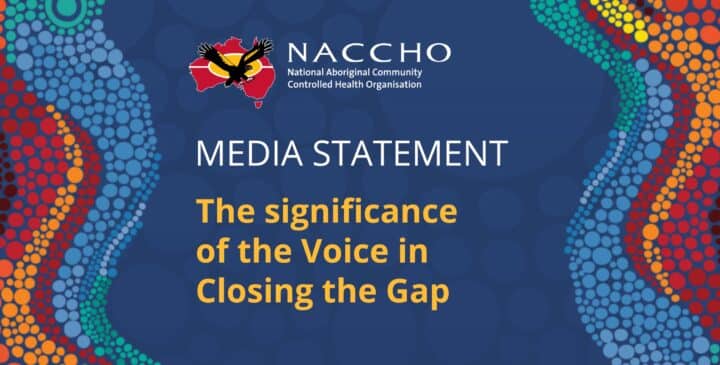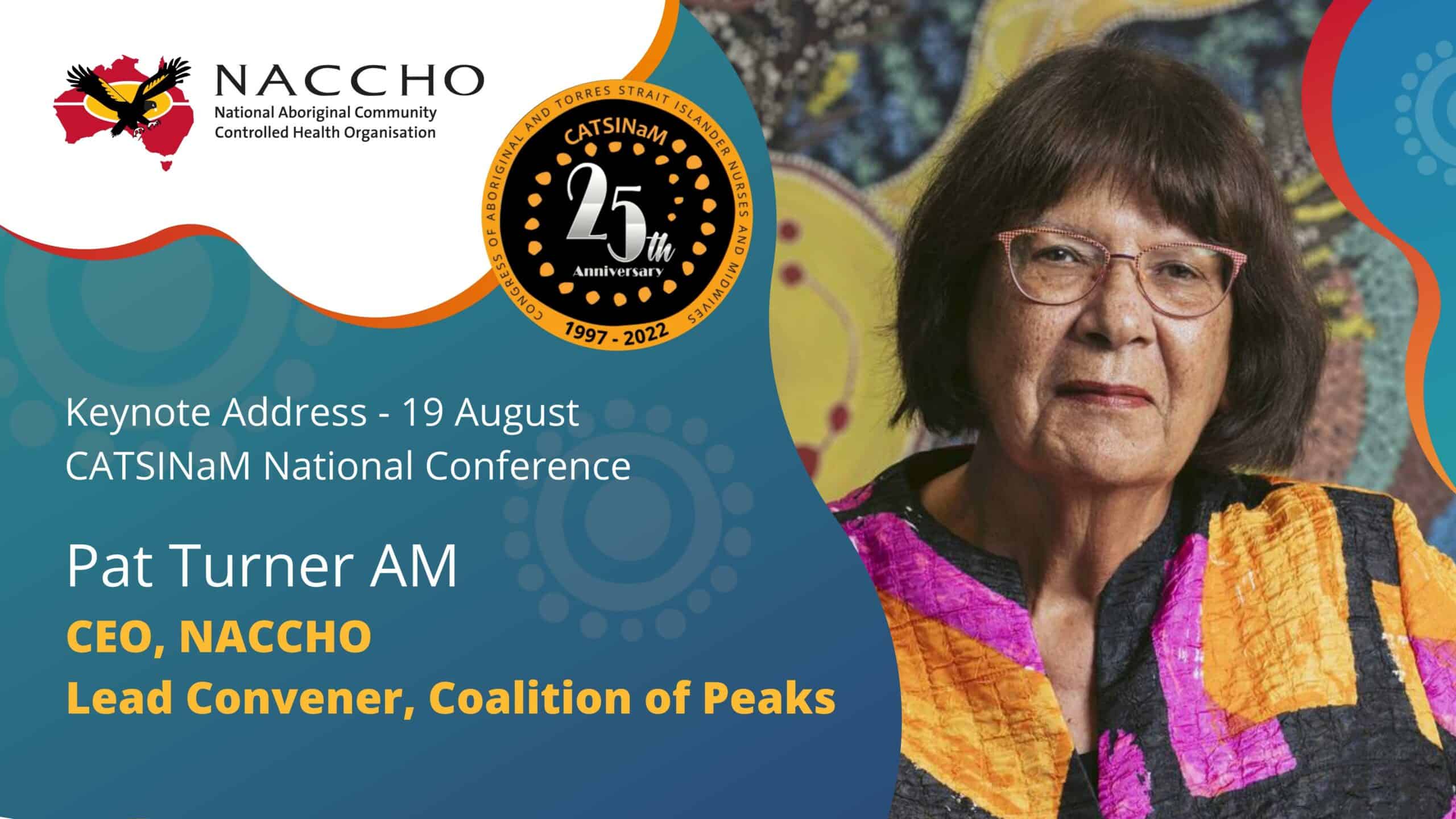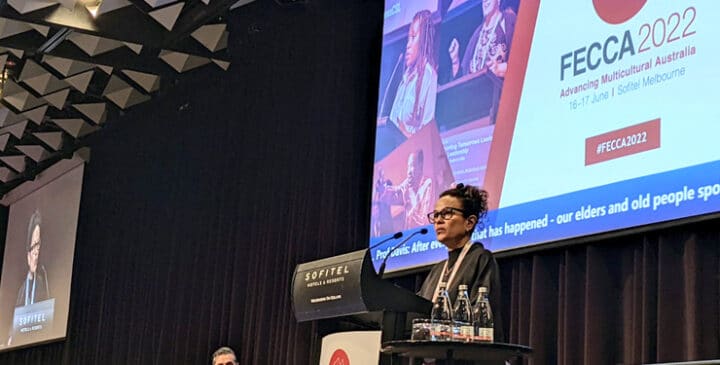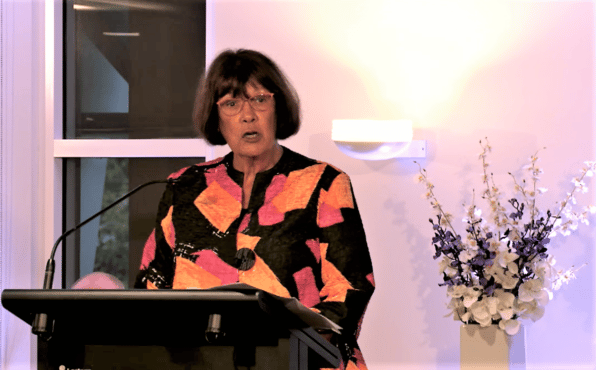

Pat Turner AM keynote address: CATSINaM National Conference 2022
Hyatt Regency, Darling Harbour, Sydney
Friday 19 August 2022
Good morning everyone. It’s a pleasure to be here with you today.
Thank you to Michael West for a very warm Welcome to Country.
I’d like to thank you for inviting me to speak at this conference which marks CATSINaM’s 25th anniversary.
My name is Pat Turner. I am the CEO of the National Aboriginal Community Controlled Health Organisation, and the Lead Convener of the Coalition of Aboriginal and Torres Strait Islander Peaks organisations.
Foremost, I am an Aboriginal woman, the daughter of an Arrente man and a Gurdanji woman.
Before I start, I’d like to acknowledge the Gadigal people of the Eora Nation, the traditional custodians of the lands where we are gathering today. I pay my respects to their Elders past and present; and thank them for their continuing openness to have us live, work, and meet on their land.
The past 50 or so years in Australia has seen some momentous changes in Aboriginal and Torres Strait Islander power, leadership, and impact.
As a country, we have had our ups and downs as we try to forge more authentic, equal, and effective partnerships between Aboriginal, Torres Strait and non-Indigenous Australians.
It is important that when we are talking about Aboriginal and Torres Strait Islander people, to remember that our people have been learning and implementing cultural practices successfully, and had high-functioning societies, well before there was a western construct of a department, or a policy.
This needs to be at the forefront when designing new policies, programs, and services to support the development of Aboriginal and Torres Strait Islander people – systems that truly acknowledge us as the First Peoples of this modern nation and which build on and recognise our strengths.
I believe our sector has been heartened by the new Prime Minister’s commitment to implementing the Uluru Statement from the Heart and the conversations happening as a result.
Of course, more detail needs to be provided and there is plenty of work ahead of us all, but the significance of the Prime Minister’s commitment and the goodwill it has generated should not be overlooked.
I also received a letter last week from the Prime Minister confirming his government’s commitment to the National Agreement on Closing the Gap.
While there is no single strategy, idea, or group that will deliver the equity and change we are entitled to, the National Agreement on Closing the Gap is fundamental to driving reform in how Australian governments interact with all Aboriginal and Torres Strait Islander people.
It is the first intergovernmental agreement designed to improve the lives of our people that has been negotiated and agreed with representatives of Aboriginal and Torres Strait Islander people across Australia.
The National Agreement commits this country to a new direction and is a pledge from all governments to fundamentally change the way they work with Aboriginal and Torres Strait Islander communities and organisations.
Genuine shared decision making between Aboriginal and Torres Strait Islander people and government, strengthening the community-controlled sector, improving mainstream institutions, and improving collection and access to Aboriginal and Torres Strait Islander data are the four priority reforms that underpin the National Agreement.
Organisations like CATSINaM and NACCHO work every day to address these Priority Reforms.
It would be a devastating step backwards, if the momentum was lost.
We know that racism and the intergenerational trauma of past practices combined with the breadth of disadvantage experienced by Aboriginal and Torres Strait Islander people contributes to the high the burden of disease experienced by our people.
The National Agreement has the ability to reduce this burden, to reduce health inequities, and it has the potential to influence system level change.
It has been designed to enable true and genuine partnerships with Aboriginal and Torres Strait Islander people as equal partners in the design and delivery of services that impact our people.
However, to achieve that change, partnership with each other, and with government is essential.
CATSINaM’s GENKE II report has a strong focus on partnership with other organisations including the Australian Nursing and Midwifery Accreditation Council (ANMAC), the Nursing and Midwifery Board of Australia (NMBA), and with government.
Indeed, NACCHO and CATSINaM continue to strengthen our partnership working together on initiatives such as the Nurse Practitioner 10-year Plan.
It is only by working together that we can achieve the systemic changes needed to make a real difference to health outcomes for our people.
Workforce
The Aboriginal and Torres Strait Islander community-controlled human services sector is facing major workforce challenges.
Demand is outstripping supply of suitably skilled and job ready Aboriginal and Torres Strait Islander employees.
NACCHO supports CATSINaM’s commitment to increasing the Aboriginal and Torres Strait Islander nursing and midwifery workforce.
This work is critical if we hope to achieve the aims of the 10 year National Aboriginal and Torres Strait Islander Health Workforce Plan.
This Plan sets an ambitious, yet achievable target, that Aboriginal and Torres Strait Islander people are fully represented in the health workforce by 2031.
The GENKE II report lays out a strong pathway to achieving that aim for nurses and midwives across our sector.
While the target is achievable, we have a lot of work to do to get there.
GENKE II notes that there has been less than 1% increase in the Aboriginal and Torres Strait Islander registered nursing workforce in the last 20 years.
We also know that the number of Aboriginal and Torres Strait Islander Health Workers and Practitioners has been declining over the years, and at NACCHO we are also working to reverse that decline.
We are experiencing workforce shortages across the sector and this shortage is already impacting access to culturally appropriate services for Aboriginal and Torres Strait Islander people nationally.
Moreover, without an overall increase in the number of Aboriginal and Torres Strait Islander people participating in the workforce, services will be competing for workers who are a limited resource across all health and care sectors.
This is why we welcome the government’s commitment to delivering a ‘First Nations Health Worker Traineeship Program’ which will see 500 trainees deployed over the next five years.
This was needed even before the pandemic, but the timing makes this measure all the more critical as the stress on the health workforce across the country is clear for all to see.
You all work across many areas of Aboriginal and Torres Strait Islander health from hospitals to prisons, and in our Aboriginal Community Controlled Health Services. You are constantly supporting and growing our workforce and strengthening cultural safety wherever you work.
You all need to be supported in that important work.
This is why it’s so important that organisations like CATSINaM and NACCHO maintain our focus on holding governments and institutions accountable to their commitments under the National Agreement.
Not just the commitment to partnership, but also the commitment to identify and eliminate racism.
To transform government organisations to ensure they work better for Aboriginal and Torres Strait Islander people.
To actively deliver culturally safe workplaces, policies, programs and practice.
We know that Aboriginal and Torres Strait Islander people continue to experience racism across the health sector and that this impacts on health outcomes.
That’s why there is a clear preference for Aboriginal and Torres Strait Islander people to access comprehensive primary health care by our ACCHOs.
We know that many will bypass mainstream services to access one where they are confident their cultural safety is guaranteed.
Because we build ongoing relationships to give continuity of care so that chronic conditions are managed and preventative health care is effectively targeted.
Our Aboriginal and Torres Strait Islander Health Workers and Health Practitioners, our nurses and midwives, our allied health staff, our doctors are the heart of the ACCHO workforce.
They, like you, are skilled, valued, and trusted members of their teams and local communities.
You are all experts in your field, and you are valued for the work that you do and the people that you support every day. You know your patients and you know your communities.
Increasing the number of Aboriginal and Torres Strait Islander nurses, midwives and other clinical staff is critical to help ensure culturally safe care for our people.
To effectively support growing demand, we need to leverage the current ACCHO workforce and draw from local communities to build a multi-disciplinary care workforce that includes both cultural and clinical experts.
Up-skilling, re-training and utilising the existing workforce and creating workforce pathways to build capacity is one key to success.
But increasing the Aboriginal and Torres Strait Islander workforce is not enough to ensure cultural safety for our people if there is no cultural safety for our workers where they deliver care.
Both the public and the private health system need to be accountable for ensuring that all Aboriginal and Torres Strait Islander people have culturally safe access to the services they need, where and when they need them.
And the health system must be equipped to provide flexible, culturally safe and place-based care across the whole life course.
I acknowledge the challenges faced by Aboriginal and Torres Strait Islander nurses and midwives— cultural isolation, carrying the cultural load and a lack of cultural safety in some settings due to racism.
NACCHO stands with CATSINaM’s commitment to reform nursing and midwifery education to improve the cultural safety of the wider nursing and midwifery workforce.
Our education system must deliver non-Aboriginal staff who can confidently deliver accredited culturally safe care. Who can be allies to Aboriginal and Torres Strait Islander staff in the workplace.
Cultural competence also has to come from the top down – the leadership of an organisation has to embrace this, to understand cultural intelligence and to have that inculcated in the staff that work directly with clients.
Without a shift in organisational thinking and approach, no amount of staff training will deliver cultural safety for Aboriginal and Torres Strait Islander people.
It is these new workers, who have been trained differently, who understand what it means to be culturally intelligent, who will support the bigger systemic changes being led by Aboriginal and Torres Strait Islander organisations like CATSINaM.
Together, we are changing the way governments work with our peoples on policies and programs that impact on us.
For example, our sector’s funding has grown in recent times providing increased security for our sector.
But despite the good news of recent years, funding pressures continue to mount.
Inflation is on the rise, and servicing costs due to pandemic measures have risen sharply and governments are now entering a phase of Budget repair.
This period of fiscal restraint is likely to extend well beyond the current Government’s three years.
But there is an even bigger funding pressure than these.
As many of you know, in May of this year, NACCHO released research from Equity Economics that estimated the gap in health expenditure for Aboriginal and Torres Strait Islander Australians.
The current gap in total recurrent health expenditure is conservatively estimated at $4.4 billion, including Commonwealth, State and Territory governments and private health expenditure.
NACCHO understands the economic environment, we know it is unlikely that a new Government will be able to find the $2.6 billion to provide health expenditure parity for Aboriginal and Torres Strait Islander people.
But it is important to note that it is not just about finding new money.
It is also about fairer access within existing appropriations.
More needs to be done to ensure that Aboriginal people access their fair share of funding in existing programs and services.
We believe that modest investments can be made that will start the process of narrowing the funding gap now.
Until we start to close the funding gap, Aboriginal and Torres Strait Islander peoples will continue to live about 8-9 years less than other Australians and suffer from disease and poor health at rates far in excess of other Australians and at levels that, frankly, would not be tolerated by other Australians.
The transference of power and importantly, of resources to Aboriginal and Torres Strait Islander organisations and communities is required to enable Aboriginal and Torres Strait Islander people to lead in decision making and the policies and programs that impact us.
We have an opportunity to work together to close the gap in health inequalities between Aboriginal and Torres Strait Islander people and other Australians.
We have the policy platform. We have the commitment. And, we are seeing some investment. But there is much, much more to do.
Thank you

